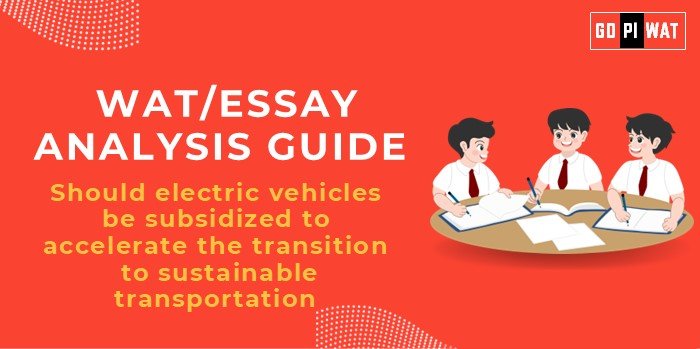📋 Written Ability Test (WAT)/Essay Analysis Guide
🌐 Understanding the Topic’s Importance
Electric vehicles (EVs) are central to the global push for decarbonization. Subsidizing EVs is a policy tool to overcome adoption barriers and promote sustainability.
🕒 Effective Planning and Writing
- Time Allocation:
- Reading & Planning: 5 minutes
- Writing: 20 minutes
- Reviewing: 5 minutes
- Preparation Tips:
- Gather key statistics and stakeholder roles.
- Focus on structuring arguments with evidence.
✍️ Introduction Techniques for Essays
- Template 1 – Contrast: “While EVs represent a sustainable future, their adoption faces cost and infrastructure challenges, prompting the debate on subsidies.”
- Template 2 – Solution-Based: “To achieve climate goals, governments must bridge the affordability gap in EVs, with subsidies being a critical tool.”
📖 Structuring the Essay Body
- Achievements: Highlight successes like subsidy-driven EV adoption in India and Norway.
- Challenges with Comparative Analysis: Discuss barriers like cost and infrastructure, referencing China and India.
- Future Outlook: Explore advancements in battery technology and policies for long-term sustainability.
📄 Concluding Effectively
- Balanced Perspective: “Subsidies are pivotal for EV adoption, but a sustainable ecosystem requires long-term planning beyond financial incentives.”
- Global Comparison: “India can emulate Norway’s success while addressing unique regional challenges to ensure equitable EV adoption.”
📊 Analyzing Successes and Shortcomings
- Key Achievements: Reduced emissions, growing EV sales.
- Ongoing Challenges: High costs, limited infrastructure.
- Global Context: Norway’s tax exemptions vs. India’s challenges in rural electrification.
💡 Recommendations for Sustainable Progress
- Introduce phased subsidy reductions paired with cost reduction strategies.
- Expand charging networks through public-private partnerships.
- Invest in local battery manufacturing to reduce reliance on imports.
📝 Sample Short Essays
Balanced Perspective:
“Subsidies for EVs are vital for addressing cost disparities. However, their success hinges on complementary investments in infrastructure and technology, as evidenced by Norway’s model.”
Solution-Oriented:
“To accelerate sustainable transportation, governments should prioritize targeted subsidies, public-private collaborations, and local manufacturing incentives.”
Global Comparison:
“While subsidies have spurred EV adoption in Norway, India must tailor its policies to overcome unique challenges like rural electrification and affordability.”


